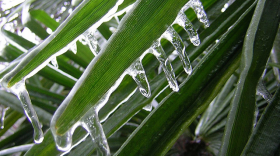Since a screwworm infestation was identified in the Lower Keys, more than 10 million sterile screwworm flies have been released on eight islands.
Sterile flies are the proven technology to eradicate screwworms. The flies are zapped with gamma radiation, making them sterile. Then those sterile flies are released to breed with wild flies. That stops reproduction, preventing more fly larvae.

Those larvae are the problem. Screwworm flies lay their eggs in open wounds. When the larvae hatch — those larvae are the actual "screwworms" — they feed on the living flesh of the host.
So far most of the victims of the screwworms have been Key deer, an endangered species that lives only in the Lower Keys. After screwworms were found in Lower Keys, the USDA began bringing in sterile flies from its lab in Panama.
The USDA and the Panamanian Ministry of Agriculture breed the flies and irradiate them there to maintain a sterile fly barrier in the Darien Gap between Colombia and Panama.
So far more than 10 million flies have been released in the Keys.
"As of yesterday, we have 25 sites in the field and we do this rain or shine for as long as it takes to eradicate this," said John Welch, who works with the USDA's Animal Plant Health Inspection Service.
The U.S. Fish & Wildlife Service has also begun treating Key deer with an anti-parasitic medicine to prevent infections or knock back minor cases.
The state of Florida is also trying to keep the screwworms from reaching the mainland, declaring an animal quarantine in the Keys and setting up a checkpoint on the Overseas Highway in Key Largo.
Florida Agriculture Commissioner Adam Putnam said almost 2,000 animals had been examined at the checkpoint by Thursday.
"We've looked at rabbits, parrots, dogs, horses, cats," he said. "None of them have shown any indication of needing treatment from screwworm."
Putnam said public awareness was key, both in checking pets for wounds and reporting any wild animals that may be affected.
"It's going to allow us to save our precious Key deer, protect our pets and protect our livestock industry in Florida," he said.
Officials say they can't tell yet how long it will take to eradicate the screwworms — or to figure out where they came from.
Putnam said he's aware other states with major livestock industries are watching the response in the Keys.
"Make no mistake, if this were in another state I would be watching it very carefully," he said.
Copyright 2020 WLRN 91.3 FM. To see more, visit WLRN 91.3 FM. 9(MDAyMTYyMTU5MDEyOTc4NzE4ODNmYWEwYQ004))








